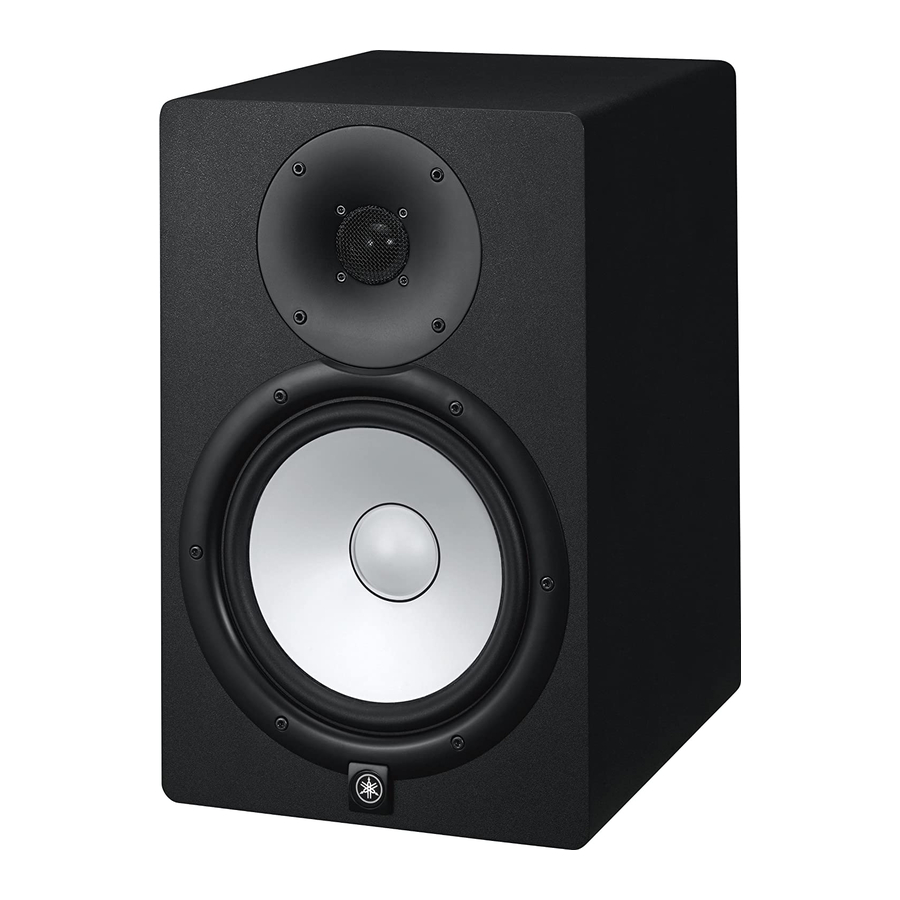
Summary of Contents for Yamaha HS 50M
- Page 1 Powered Near-field Reference Monitors & Subwoofer OWNER’S MANUAL BEDIENUNGSANLEITUNG MODE D’EMPLOI MANUAL DE INSTRUCCIONES 取扱説明書...
-
Page 2: Important Safety Instructions
N or coloured BLACK. The wire which is coloured BROWN must be connected to the terminal which is marked with the letter L or coloured RED. • This applies only to products distributed by Yamaha-Kemble Music (U.K.) Ltd.(3 wires) (98-6500) - Page 3 Bitte bewahren Sie diese Bedienungsanleitung zum späteren Nachschlagen an einem sicheren Or t auf. Nous vous remercions d’avoir choisi un haut-parleur de contrôle ou un caisson de basses amplifié YAMAHA. Pour obtenir les performances optimales de vos haut-parleurs et garantir une longévité maximale, lisez attentivement ce mode d’emploi avant d’utiliser le haut-parleur de contrôle ou le caisson de basses amplifié.
-
Page 4: Please Read Carefully Before Proceeding
• Company names and product names used in this Owner’s Manual are trademarks or registered trademarks of their respective owners. • Specifications and descriptions in this owner’s manual are for information purposes only. Yamaha Corp. reserves the right to change or modify products or specifications at any time without prior notice. Since specifications, equipment or options may not be the same in every locale, please check with your Yamaha dealer. -
Page 5: Getting Connected
Unlike most other audio and production gear, the way speakers are set up in a room has a dramatic effect on the final sound. This short tutorial provides a basic guide to help you maximize the performance of your Yamaha HS-series monitor speakers. -
Page 6: Xlr-Type Connector
Pin 2: Signal + or “Hot” If you’re connecting your HS speakers directly to a mixer such as one of the Yamaha MG-series mixers, they should usually be connected to the mixer’s “C-R” (Control Room) outputs so that you can control the monitor level without affecting the level of the signal sent to the mixer’s... -
Page 7: Speaker Placement
The HS-series speakers are also an excellent choice for direct connection to your electronic keyboard or other electronic musical instrument. Speaker Placement Speaker placement is one of the most important considerations when setting up a monitor system, but it is all too often overlooked with the result that performance is seriously compromised. -
Page 8: Sweet Spot
Fine-tuning for Stereo The speaker LEVEL controls should be set to the same level. A setting of about 12 o’clock corresponds to a nominal input level of about +4 dB. Since no subwoofer is being used in this setup, set the LOW CUT switch to “FLAT”. When set to “-2 dB”... -
Page 9: Adding A Subwoofer
Even if you don’t plan to set up a surround system, adding a subwoofer can be a real advantage for stereo mixing. If you can’t hear the extreme low end there’s not much you can do to make it sound great. The extended bass response provided by a good subwoofer can indeed help you to improve the overall quality of your mixes. - Page 10 If you’re connecting your HS-series speakers to a mixing console that features built-in surround handling capability — such as the Yamaha DM2000, DM1000, or 02R96 — each speaker will be connected directly to the console output dedicated to handling that particular surround channel. In this type of setup you can take full advantage of the console’s advanced surround mixing and bass...
-
Page 11: Maintain A Consistent Monitoring Level
Fine-tuning for Surround Set the HS50M or HS80M LEVEL control to about 12 o’clock to set the nominal input level to approximately +4dB. If you’re using the HS50M set the HS10W LEVEL control to about 10 o’clock, and if you’re using the HS80M set it to about 11 o’clock. -
Page 12: Rear Panel
Rear Panel HS80M, HS50M HS80M MID EQ +2dB -2dB 2kHz ROOM CONTROL -2dB -4dB 500Hz HIGH TRIM +2dB -2dB 2kHz LOW CUT FLAT 80Hz 100Hz POWER switch Turns power to the speaker on or off. When the power is turned on the tuning fork mark on the front panel will light. "... - Page 13 HS10W INPUT " POWER switch Turns power to the speaker on or off. When the power is turned on the tuning fork mark on the front panel will light. " INPUT L/R connector These are balanced XLR-type and phone type input connectors.
-
Page 14: Specifications
Specifications Model General Specifications Type Biamp 2-way Powered speaker Crossover Frequency 3 kHz Overall Frequency 55 Hz—20 kHz (-10 dB) Response 165 x 268 x 222 mm Dimensions (W x H x D) (6-1/2 x 10-9/16 x 8-3/4") Weight 5.8 kg Speaker Components LF : 5"... -
Page 15: Performance Graph
HS10W 300 (11-13/16") Performance graph HS50M FREQUENCY (Hz) Block Diagram HS50M / HS80M INPUT 1 LOW CUT LEVEL INPUT 2 HS10W OUTPUT INPUT INPUT INPUT INPUT OUTPUT EXTSUB OUT 386 (15-3/16") HS80M FREQUENCY (Hz) HIGH TRIM MID EQ ROOM CONTROL LOW BOOST LOW CUT STEP FILTER... - Page 16 For details of products, please contact your nearest Yamaha representative or the authorized distributor listed below. NORTH AMERICA CANADA Yamaha Canada Music Ltd. 135 Milner Avenue, Scarborough, Ontario, M1S 3R1, Canada Tel: 416-298-1311 U.S.A. Yamaha Corporation of America 6600 Orangethorpe Ave., Buena Park, Calif. 90620, U.S.A.









